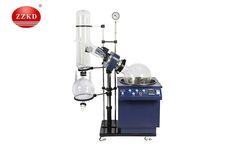Last Updated on March 13, 2024 by admin
Are you looking forward to knowing about the evaporator uses in the laboratory? Here you will find the uses in the laboratory. You are allowing compounds to be extracted more efficiently than ordinary distillation-condensation systems. Let us tell you about the uses of the rotary evaporator in laboratories so that you should know how it is beneficial to use in the laboratory.
Uses:
- This device is widely used in the chemical industry, where it is used to evaporate substances through the distillation process, then condense them and finally separate them into their components, thanks to certain boiling points. Due to all the benefits of purchasing this instrument, many laboratories in this industry have one.
- Many industries use laboratory evaporators to prepare samples for analysis. Pharmaceutical, food, oil and chemical companies use evaporators for this reason. Users can save time and increase laboratory productivity by performing solvent removal faster and more efficiently than atmospheric pressure evaporation.
- Part of this accelerated evaporation is due to the formation of a film on the inner surface of the bulb, which greatly increases evaporation. Therefore, solvent removal can be achieved relatively quickly (depending on volume and solvent). Rotary evaporators are easy to use and widely used in laboratories.
- The mini rotary evaporator is a smaller version of the rotary evaporator and is mainly used for vacuum distillation. It is widely used in laboratories, where it is mainly used for various distillation purposes. The distillation process is carried out by evaporating compounds using low boiling point solvents, such as ethyl alcohol or butane, eliminating solids at constant temperature and pressure throughout evaporation.
- For product quality, you must follow the instructions carefully and not spoil the product. The best way to achieve this is to lower the boiling point by lowering the pressure ratio.
- It allows the distillation to be carried out at the lowest temperature. You should also use the efficient heat transfer method and achieve faster industrial separation when you need to reduce pressure. Vacuum distillation is one of the best extraction and distillation methods. And you can achieve this by lowering several boiling points. The unit of the rotary evaporator varies and depends on the capacity of the mini rotary evaporator.
- It is used in solvent removal in the laboratory as a mini rotary evaporator, also known as a “Rotovap”. A rotary evaporator is essentially vacuum distillation: a solution in a round-bottomed flask is placed in the apparatus’s water bath and rotated. At the same time, the system is partially emptied (using a water jet or vacuum pump). Due to the negative pressure in the apparatus, the solvent boils at a lower temperature than normal. The difference between distillation and rotary evaporation is that the distillate is mainly used in the distillation residue, and the residue remains in rotary evaporation.
- According to their respective volatility through evaporation and condensation (liquid-gas-liquid).
Intended Use of the Rotary Evaporator:
We use the rotary evaporator for two main purposes:
- Concentrate the nonvolatile components of a mixture (e.g. concentrate the purest, freshest flavors of a blood orange by removing the water);
- Gently remove volatile flavor and aroma molecules from mixtures at low temperatures (e.g., extract desired flavors from a mixture of alcohol, herbs, and fruit without heating the mixture).
- The key to understanding any distillation is remembering it is a distillation. Sugars, acids, dyes, and most bitter substances can be removed from flavors, alcohols, water, small flavor molecules, etc. they’re separated.
- Unlike standard distillation, the amazing thing about rotary evaporative distillation is that it can separate food ingredients without changing them.
- Most rotary evaporators have four main components: heat bath, rotor, condenser and solvent trap. In addition, an aspirator or vacuum pump should be connected, a rattle trap and a round-bottom flask containing the sample to be concentrated.
Bottle, Damper and Bath Temperature:
Choose a bottle that can hold approx—twice the original volume. Be careful; the shock trap’s volume is not important, but in the case of chocolate, it should always be used as it does not have to take the sample from the condenser and solvent trap. A weak vacuum pump or wash vacuum and temperatures between 25 and 50°C are sufficient for most common laboratory solvents. Lower temperatures slow the process but reduce the risk of crashes.
Apart from this, if you are interested to know about Health Benefits of Turkey Tail Mushroom then visit our Health category.
